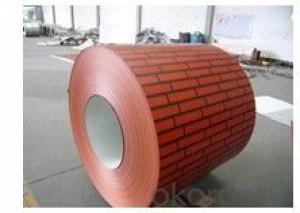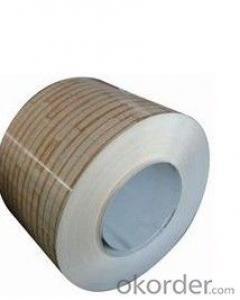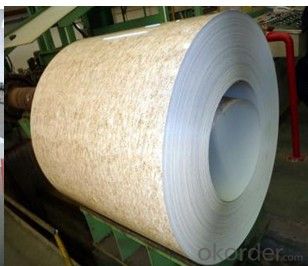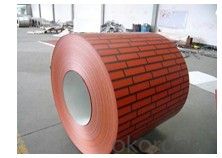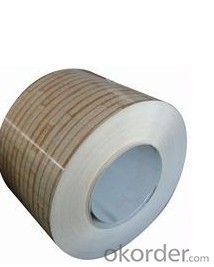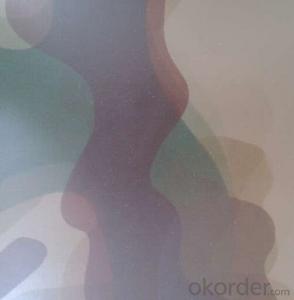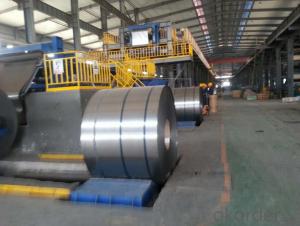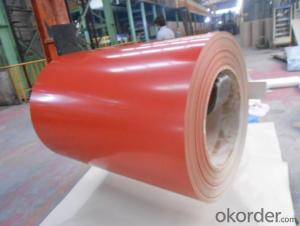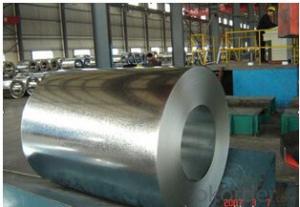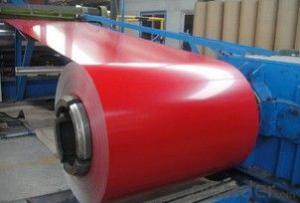EXCELLENT PATTERN PREPAINTED GALVANIZED STEEL COIL
- Loading Port:
- China Main Port
- Payment Terms:
- TT OR LC
- Min Order Qty:
- -
- Supply Capability:
- -
OKorder Service Pledge
OKorder Financial Service
You Might Also Like
EXCELLENT PRINT PREPAINTED GALVANIZED STEEL COIL
| Standard: | AISI,ASTM,BS,DIN,GB,JIS | Grade: | SGCC/CGCC/DX51D,CGCH,CGLCC | Thickness: | 0.13-0.8-1.2mm |
| Place of Origin: | China (Mainland) | Brand Name: | HJ steel | Model Number: | 0.42*1219*C mm |
| Type: | Steel Coil | Technique: | Cold Rolled | Surface Treatment: | Coated |
| Application: | Building construction,warehouse | Special Use: | Wear Resistant Steel | Width: | 1000/1200/1220/1250mm or under as request |
| Length: | coil or sheet as your require | color: | ALL RAL CO | zinc coating: | 50-140g/m2 |
| paint: | top side :15-25um back side :5-10um | Temper: | Full hard ,half hard ,soft |
MAIN SPECIFICATIONS:
1,Base Metal: Prepainted galvanized Steel Coil (PPGI/PPGL)
2,Zinc Coating: z50-z150,Az40-Az150
3,Thickness: 0.13-0.8-1.2mm
4,Width:914mm-1250mm or under as your require
5,Length: according to your requirement (unit of measurement: Ton)
6,Paint Coating: top side :15-25um back side :5-10um
7,Color:RAL color or customized as the sample
8,Minimun order:25Tons
9,Packaging Details: Fully seaworthy export packing
10,Price Terms:Fob Shanghai,CIF,CFR
- Q: What are the different types of steel coil cutting processes?
- There are several different types of steel coil cutting processes that are used in various industries. 1. Shearing: This is the most common and simplest method of steel coil cutting. It involves using a shear blade to cut the coil material into desired lengths. Shearing can be done manually or with the help of automated machinery. 2. Slitting: Slitting is a process used to cut wide coils into narrower strips. It involves passing the coil material through a set of circular knives that cut the steel into multiple smaller coils or strips of desired width. 3. Laser cutting: Laser cutting is a highly precise and efficient method of cutting steel coil. It involves using a high-powered laser to melt or vaporize the material along a predetermined path. Laser cutting is commonly used for intricate designs or when high accuracy is required. 4. Plasma cutting: Plasma cutting is another method used to cut steel coil. It involves using a plasma torch that generates a high-velocity jet of ionized gas to melt the material. Plasma cutting is known for its speed and ability to cut through thick materials. 5. Waterjet cutting: Waterjet cutting is a process that uses a high-pressure stream of water mixed with abrasive particles to cut through steel coil. This method is often used when the material being cut is sensitive to heat or when precision is required. 6. Saw cutting: Saw cutting is a traditional method of cutting steel coil. It involves using a saw blade with teeth to cut through the material. Saw cutting is effective for thicker materials and can be done manually or with the help of automated machinery. These are just a few of the different types of steel coil cutting processes that are commonly used. The choice of cutting method depends on factors such as the type and thickness of the material, desired accuracy, speed, and cost-effectiveness.
- Q: How are steel coils used in the manufacturing of steering systems?
- Steel coils are used in the manufacturing of steering systems as they provide the necessary strength and durability required for the components of the system, such as steering columns, gears, and shafts. These coils are shaped and formed into various parts through processes like cutting, bending, and welding, ultimately contributing to the overall stability and functionality of the steering system in vehicles.
- Q: My neighbor who has an older model mustang installed a steel clutch in it and has blown 4 transmissions as a result.Can any mechanic explain why a steel clutch would kill transmissions? What other modifications would the car need in order to prevent this?
- figger he would learn after a tranny or two...no reasion for any clutch to wreck a tranny.must b bad instalation..or he cant drive
- Q: I'm doing a commercial for chemistry and I need to know any kind of chemistry dealing with Callaway Big Bertha Irons. I know they are stainless steel but any more info would help out! Thank you! :)
- Stainless steel is a mixture of metals, each metal is included in order to make up for each others weaknesses. Each metal is included due to a property that is benificial in some way, for instance Chromium is included because it makes the stainless steel 'stainless'. In chemistry a mixture of metals, stainless steel, is called an alloy.
- Q: How are steel coils processed for cutting to length or blanking?
- Steel coils are typically processed for cutting to length or blanking through a series of steps. First, the coils are unwound using a machine called an uncoiler, which feeds the steel into the cutting process. Then, the steel passes through a leveler to ensure a flat surface. Next, it enters a shear or blanking process, where the steel is cut into desired lengths or shapes. Finally, the cut pieces are stacked or packaged for further use or distribution.
- Q: What are the different types of steel coil storage methods?
- There are several types of steel coil storage methods, including stacking coils vertically, using coil cradles or saddles, utilizing coil racks or frames, employing coil lifters or C-hooks, and implementing automated coil storage systems. Each method is designed to accommodate different storage requirements and ensure the safety and efficient handling of steel coils.
- Q: How are steel coils used in the manufacturing of suspension arms?
- Steel coils are used in the manufacturing of suspension arms as they provide strength and flexibility to absorb shocks and vibrations. These coils, also known as coil springs, are compressed and installed in the suspension system to support the weight of the vehicle and maintain proper ride height. The use of steel coils allows for better handling, stability, and improved overall performance of the suspension arms.
- Q: will peircers use surgical steel? how do you know for sure what they are using?
- When you go to get your tongue pierced they will tell you exactly what their doing and what their using. And I had my belly button pierced, and my boyfriend has his tongue and eye brow pierced and it's all done with surgical steel. Piercers wont use anything but that.
- Q: I have a set of steel pans with copper bottoms. When I cook with oil it always burns the oil to the pan and takes days to clean. I don't think I should use steel wool, since it might scratch the surface. Does anyone know a faster way to clean scorched oil off a steel pan?
- Use a Mr. Clean Magic Erasure. I swear, you will be amazed at how easily it gets your pots and pans clean! It shines them right up! That oil will come right off. Make sure you do wash it with dish soap and warm water after using the Magic Erasure.
- Q: What are the different types of steel coil surface finish treatments?
- There are numerous options for treating the surface finish of steel coils, each serving a distinct purpose and offering unique qualities. Several common types include: 1. Hot Rolling: This is a fundamental and widely-used treatment method for steel coil surface finish. It involves heating the steel above its recrystallization temperature and then rolling it to achieve the desired thickness. This process yields a rough surface texture. 2. Cold Rolling: In contrast to hot rolling, cold rolling involves rolling the steel coil at room temperature. This treatment produces a smoother surface finish with improved dimensional accuracy and tighter tolerances. 3. Galvanization: Galvanization is a process in which a protective zinc coating is applied to the surface of the steel coil. This treatment not only enhances the appearance, but also provides excellent corrosion resistance, making it suitable for outdoor applications. 4. Electro-Galvanization: Similar to galvanized steel, electro-galvanized steel coil is coated with a layer of zinc. However, this coating is applied through an electroplating process, resulting in a thinner and more controlled coating. 5. Pre-Painting: Pre-painting involves applying a layer of paint or protective coating to the steel coil before it is delivered to the customer. This treatment enhances the appearance and provides additional protection against corrosion. 6. Stainless Steel: The surface finish treatment for stainless steel coils involves passivating the steel to remove any impurities or contaminants on the surface. This process improves corrosion resistance and gives the steel a clean and smooth appearance. 7. Embossing: Embossing is a treatment where a pattern or design is pressed into the surface of the steel coil. This treatment enhances the aesthetic appeal and can provide added grip or texture, depending on the specific design. 8. Brushing: Brushing is a treatment that involves using a fine abrasive material to create a brushed pattern on the surface of the steel coil. This finish provides a unique texture and can help conceal scratches or imperfections. These are just a few examples of the different surface finish treatments available for steel coils. The choice of treatment depends on the specific requirements of the application, such as appearance, corrosion resistance, or functionality. It is crucial to select the most suitable treatment to ensure the desired outcome.
Send your message to us
EXCELLENT PATTERN PREPAINTED GALVANIZED STEEL COIL
- Loading Port:
- China Main Port
- Payment Terms:
- TT OR LC
- Min Order Qty:
- -
- Supply Capability:
- -
OKorder Service Pledge
OKorder Financial Service
Similar products
Hot products
Hot Searches
Related keywords

